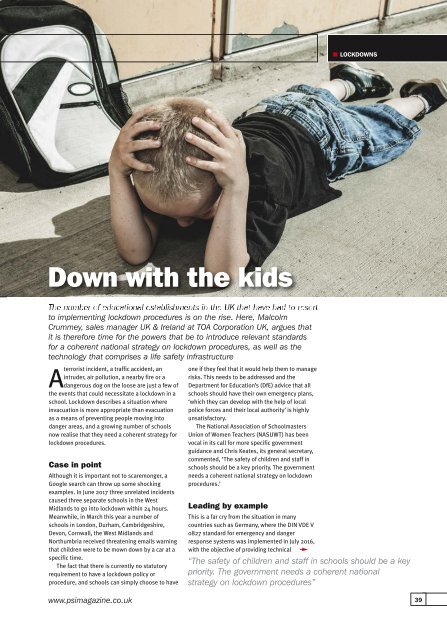PSISeptember2018
You also want an ePaper? Increase the reach of your titles
YUMPU automatically turns print PDFs into web optimized ePapers that Google loves.
LOCKDOWNS<br />
Down with the kids<br />
The number of educational establishments in the UK that have had to resort<br />
to implementing lockdown procedures is on the rise. Here, Malcolm<br />
Crummey, sales manager UK & Ireland at TOA Corporation UK, argues that<br />
it is therefore time for the powers that be to introduce relevant standards<br />
for a coherent national strategy on lockdown procedures, as well as the<br />
technology that comprises a life safety infrastructure<br />
Aterrorist incident, a traffic accident, an<br />
intruder, air pollution, a nearby fire or a<br />
dangerous dog on the loose are just a few of<br />
the events that could necessitate a lockdown in a<br />
school. Lockdown describes a situation where<br />
invacuation is more appropriate than evacuation<br />
as a means of preventing people moving into<br />
danger areas, and a growing number of schools<br />
now realise that they need a coherent strategy for<br />
lockdown procedures.<br />
Case in point<br />
Although it is important not to scaremonger, a<br />
Google search can throw up some shocking<br />
examples. In June 2017 three unrelated incidents<br />
caused three separate schools in the West<br />
Midlands to go into lockdown within 24 hours.<br />
Meanwhile, in March this year a number of<br />
schools in London, Durham, Cambridgeshire,<br />
Devon, Cornwall, the West Midlands and<br />
Northumbria received threatening emails warning<br />
that children were to be mown down by a car at a<br />
specific time.<br />
The fact that there is currently no statutory<br />
requirement to have a lockdown policy or<br />
procedure, and schools can simply choose to have<br />
one if they feel that it would help them to manage<br />
risks. This needs to be addressed and the<br />
Department for Education’s (DfE) advice that all<br />
schools should have their own emergency plans,<br />
‘which they can develop with the help of local<br />
police forces and their local authority’ is highly<br />
unsatisfactory.<br />
The National Association of Schoolmasters<br />
Union of Women Teachers (NASUWT) has been<br />
vocal in its call for more specific government<br />
guidance and Chris Keates, its general secretary,<br />
commented, ‘The safety of children and staff in<br />
schools should be a key priority. The government<br />
needs a coherent national strategy on lockdown<br />
procedures.’<br />
Leading by example<br />
This is a far cry from the situation in many<br />
countries such as Germany, where the DIN VDE V<br />
0827 standard for emergency and danger<br />
response systems was implemented in July 2016,<br />
with the objective of providing technical<br />
“The safety of children and staff in schools should be a key<br />
priority. The government needs a coherent national<br />
strategy on lockdown procedures”<br />
www.psimagazine.co.uk<br />
39

















